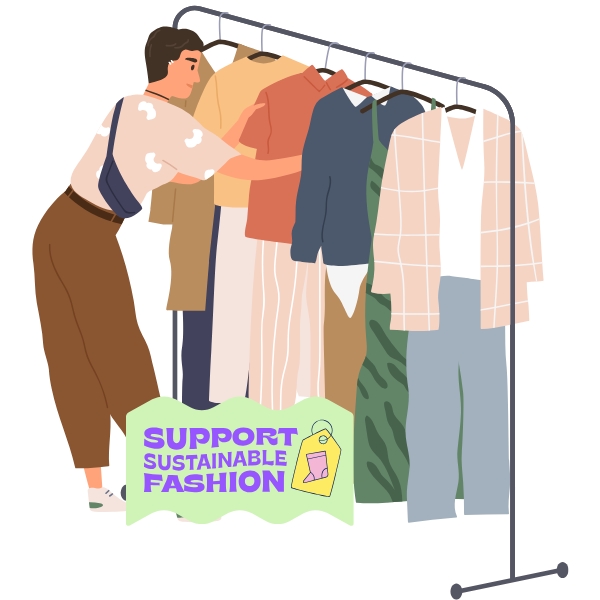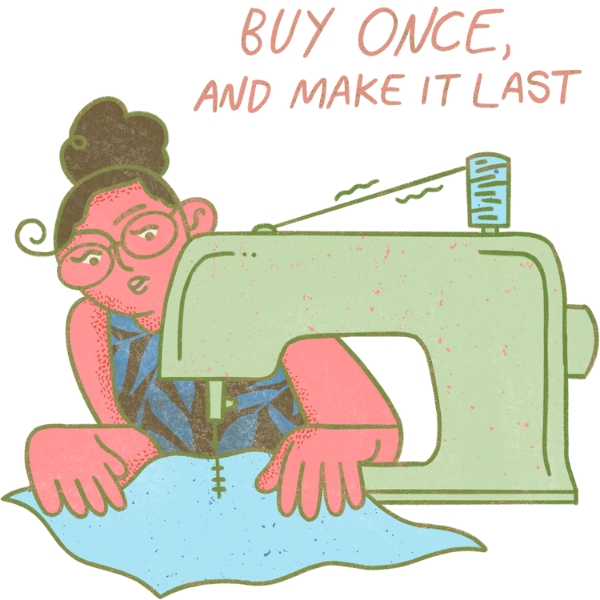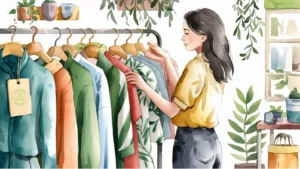We girls have always loved fashion—it’s how we express our beauty, creativity, and identity. But in a world dominated by fast fashion, many of us are beginning to question the true cost of our clothing. Enter this beginner’s guide to sustainable fashion: a simple, empowering path toward style that aligns with your values. Choosing sustainable fashion isn’t just a trend—it’s a mindful shift that benefits both your wardrobe and the planet. Whether you’re new to the idea or ready to make a change, this guide will help you build a closet that looks good, feels good, and does good.
What Is Sustainable Fashion?
Sustainable fashion prioritizes environmental and social responsibility in every step of clothing production. It’s about rethinking the entire lifecycle of your wardrobe, from the materials used to how garments are made and even what happens to them at the end of their life. This means designing, manufacturing, distributing, and using clothes in ways that minimize harm to the planet and its people. Key practices include reducing water consumption, avoiding harmful chemicals, ensuring fair labor conditions, and choosing renewable resources. Sustainable fashion also encourages reusing and recycling garments, extending their lifespan, and reducing waste.
It’s more than just wearing clothes; it’s about embracing a lifestyle that values quality over quantity and ethics over excess. By opting for timeless, well-made pieces and supporting brands with sustainable practices, you can make a positive impact on the environment while cultivating a wardrobe you’re truly proud of. Sustainable fashion isn’t just a trend—it’s a commitment to a better future for everyone.

Why Sustainable Fashion Matters
The fashion industry’s impact is staggering and far-reaching. Here are some key concerns:
- 10% of global carbon emissions: From production to transportation, the carbon footprint of fast fashion rivals entire industries.
- 20% of global water waste: The dyeing process alone consumes vast quantities of water, polluting rivers and local ecosystems.
- 85% of textiles ending up in landfills annually: Most clothing items are made of synthetic fibers that can take decades to decompose.
- Microplastics polluting oceans: Washing synthetic garments releases tiny plastic fibers that harm marine life.
- Significant human rights concerns: Garment workers often face unsafe conditions, long hours, and unfair wages.
By choosing sustainable fashion, you help reduce environmental damage, support ethical practices, and promote a healthier planet for future generations. Your wardrobe becomes a reflection of your values and a tool for positive change.
Key Principles of Sustainable Fashion
1. Quality Over Quantity
- Invest in well-made, durable clothing: High-quality fabrics and stitching ensure your pieces last longer.
- Opt for timeless styles: Classic designs never go out of fashion, reducing the need for frequent replacements.
- Calculate cost-per-wear: Divide the item’s price by the number of times you’ll wear it. A $100 jacket worn 100 times costs $1 per wear—a better value than a $20 jacket worn twice.
- Avoid fast trends: Trendy pieces may seem appealing but often become outdated quickly, adding to waste.
2. Ethical Production
- Fair wages and safe working conditions: Support brands that treat workers with dignity and respect.
- Transparent supply chains: Look for companies that disclose their production practices, from sourcing to manufacturing.
- Local production: Reduces transportation emissions and often supports small businesses.
- Artisanal craftsmanship: Handmade pieces showcase cultural heritage and unique designs, often produced sustainably.
3. Eco-Friendly Materials
- Organic and natural fibers: Fabrics like organic cotton, hemp, and linen are biodegradable and require fewer chemicals to produce.
- Recycled and upcycled materials: Many brands now use materials made from recycled plastics, old garments, or leftover fabrics.
- Low-impact dyes: These minimize water waste and toxic runoff.
- Biodegradable fabrics: Choose materials that break down naturally, leaving minimal environmental impact.
Getting Started: Practical Steps
1. Audit Your Wardrobe
- Sort and categorize: Group items by type (shirts, pants, etc.) to get a clear overview.
- Identify gaps: Notice what’s missing or overrepresented in your wardrobe.
- Assess wearability: Keep items you wear frequently and donate or sell those you don’t.
- Repair and repurpose: Extend the life of clothes by fixing minor damages or transforming them into new styles.
2. Build a Capsule Wardrobe
- Start with basics: Neutral colors and simple patterns form the foundation.
- Prioritize versatility: Choose pieces that mix and match easily.
- Reflect your style: Ensure your capsule wardrobe aligns with your taste and lifestyle.
- Plan for all seasons: Invest in layers and multi-seasonal clothing to minimize the need for new purchases.
3. Shop Mindfully
- Research before buying: Look into brands’ sustainability practices.
- Seek certifications: Labels like Fair Trade, GOTS (Global Organic Textile Standard), and OEKO-TEX indicate ethical and eco-friendly production.
- Explore secondhand options: Thrift stores, vintage shops, and online platforms offer unique finds at affordable prices.
- Support local designers: Buying locally not only reduces your carbon footprint but also fosters community.
4. Care for Your Clothes
- Follow care labels: Proper washing and drying techniques extend garment life.
- Use cold water: Saves energy and prevents fabric damage.
- Air dry whenever possible: Reduces wear and tear from machines.
- Repair promptly: Fix small issues like loose buttons or small tears before they worsen.
Brands to Kickstart Your Sustainable Journey
Entry-Level Price Point
- Everlane: Known for its radical transparency in pricing and ethical production.
- Patagonia: A leader in sustainable outdoor wear, offering lifetime repairs.
- Reformation: Combines trendy designs with an environmental focus.
Mid-Range Options
- Eileen Fisher: Features timeless styles and a take-back program to recycle old pieces.
- Vetta: Specializes in capsule wardrobe collections that simplify sustainable shopping.
- Outerknown: Offers casual wear made from eco-conscious materials.
Luxury Brands
- Stella McCartney: A pioneer in high-end sustainable fashion, avoiding leather and fur.
- Another Tomorrow: Merges luxury with ethical basics and full transparency.
- Mara Hoffman: Known for its vibrant designs and commitment to sustainability.
Alternatives to Traditional Shopping
Secondhand Options
- Online platforms: Websites like ThredUp, Depop, and Poshmark make thrifting accessible from home.
- Local thrift stores: Hidden gems await in secondhand shops.
- Clothing swaps: Trade items with friends or community groups for a fresh wardrobe at no cost.
Rental Services
- Rent the Runway: Perfect for special occasions or trying out new styles.
- Nuuly: A subscription service offering rotating wardrobes.
- Local rental boutiques: Often provide unique pieces for short-term use.

Debunking Myths About Sustainable Fashion
Myth 1: Sustainable fashion is too expensive.
While upfront costs may be higher, the longevity and quality of sustainable pieces often make them more cost-effective. Thrifting and swapping are budget-friendly alternatives.
Myth 2: Sustainable fashion isn’t stylish.
From minimalist basics to bold luxury pieces, sustainable brands cater to diverse tastes. Major fashion houses are also embracing eco-friendly practices.
Myth 3: Individual choices don’t matter.
Every purchase sends a message to the industry. Consumer demand drives innovation and better practices.
Creating Lasting Change
For You:
- Set achievable goals: Start small by focusing on one area, like reducing impulse buys.
- Track your progress: Monitor how your wardrobe evolves.
- Share your journey: Inspire others by discussing your sustainable fashion choices.
For the Industry:
- Support ethical brands: Your purchases help sustain better practices.
- Engage actively: Provide feedback to brands and participate in awareness campaigns.
- Stay informed: Follow sustainable fashion news to keep up with innovations.
Resources for Further Learning
Books
- “The Conscious Closet” by Elizabeth L. Cline: Insightful strategies for sustainable living.
- “ Fashionopolis:The Price of Fast Fashion and The Future of Clothes” by Dana Thomas
Documentaries
The True Cost of Fast Fashion By The Economist
Raise Yourself Today in Simple Style
A better you is the one with a better environment too. Begin your sustainable fashion journey today, and let your choices speak volumes about your values. Every thoughtful decision—from the clothes you wear to the way you care for them—is a step toward a healthier planet and a more empowered version of yourself.
Sustainable fashion is more than just a way to dress; it’s a statement of who you are and the world you want to create. By embracing this journey, you’re contributing to a global movement that values responsibility, creativity, and beauty. Let’s raise a more sustainable and stylish you—because conscious fashion never goes out of style, and neither do the principles of care and compassion it embodies. Together, we can make fashion a force for good-let’s shine with our kindness to the world.
More about Mindful Living
Simple Living at Home: Your Room-by-Room Minimalist Guide
Affiliate Disclosure: This post contains affiliate links. If you purchase something through these links, I may earn a small commission at no additional cost to you.




